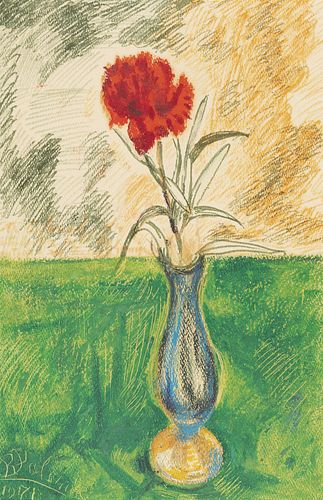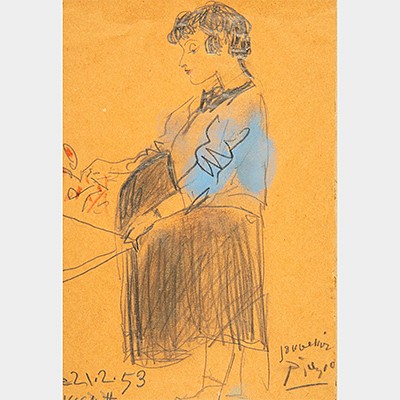BENJAMÍN PALENCIA (Barrax, Albacete, 1894 - Madrid, 1980). "Vase with Carnation, 1971. Wax on paper. Signed and dated in the lower left corner.
Lot 19
About Seller
Setdart Auction House
Carrer Aragó 346
Barcelona
Spain
Setdart Subastas was born in 2004 and is currently the first online art auction in Spain with solidity, prestige and reliability guaranteed by our more than 60,000 users. Setdart has a young, dynamic and enterprising team ready to successfully manage the purchase and sale of art works through custom...Read more
Categories
Estimate:
EUR€1,500 - EUR€1,800
$1,578.95 - $1,894.74
Absentee vs Live bid
Two ways to bid:
- Leave a max absentee bid and the platform will bid on your behalf up to your maximum bid during the live auction.
- Bid live during the auction and your bids will be submitted real-time to the auctioneer.
Bid Increments
| Price | Bid Increment |
|---|---|
| EUR€0 | EUR€10 |
| EUR€200 | EUR€25 |
| EUR€500 | EUR€50 |
| EUR€1,000 | EUR€100 |
| EUR€3,000 | EUR€200 |
| EUR€5,000 | EUR€500 |
| EUR€10,000 | EUR€1,000 |
| EUR€20,000 | EUR€2,000 |
| EUR€50,000 | EUR€5,000 |
About Auction
By Setdart Auction House
Sep 20, 2021
Set Reminder
2021-09-20 08:00:00
2021-09-20 08:00:00
America/New_York
Bidsquare
Bidsquare : CONTEMPORARY ART
https://www.bidsquare.com/auctions/setdart-auction-house/contemporary-art-7482
Setdart Auction House sofia@setdart.com
Setdart Auction House sofia@setdart.com
- Lot Description
BENJAMÍN PALENCIA (Barrax, Albacete, 1894 - Madrid, 1980). "Vase with Carnation, 1971. Wax on paper. Signed and dated in the lower left corner. Work referenced in the Benjamín Palencia Archive with registration number D010/71. Measurements: 47 x 32 cm; 67 x 50 cm (frame). After beginning his training as a self-taught artist, Palencia moved to Madrid at the age of fifteen. In the capital he entered the Julio Moisés Free Academy, where he coincided with other outstanding painters such as Salvador Dalí. In 1926 he travelled to Paris and met Picasso and Miró, and on his return to Madrid he made his individual debut at the Museum of Modern Art (1928). He then made several study trips to Italy, Berlin and New York. In 1941 he founded the Vallecas School, and in 1943 he was awarded the First Medal at the National Exhibition of Fine Arts. In 1974 he was appointed a member of the San Fernando Royal Academy of Fine Arts, and a few years later of the San Jorge Academy of Fine Arts in Barcelona. Benjamín Palencia's style, starting from surrealism, cubism and other avant-garde movements, finally evolved towards an austere realism. Gradually, his style became more intense and powerful, with the forms acquiring greater volume and, in painting, the painter's concern focusing on the luminous aspects. Focusing his work on landscape painting, he tried to restart a second Vallecas School together with Álvaro Delgado, Carlos Pascual de Lara, Gregorio del Olmo, Enrique Núñez Casteló and Francisco San José. His paintings and drawings would include images of the Castilian countryside and the figures to be found in it, peasants and animals, bulls, horses, goats, etc. His painting became a testimony of the rough, the uncouth and the rural, the sober Castilian and the Spanish. Palencia is represented in the Reina Sofía National Museum, in the Patio Herreriano in Valladolid and in the Fine Arts Museums of Valencia and Albacete, among many others.
- Shipping Info
-
In-house shipping available. Please inquire at admin@setdart.com.
-
- Buyer's Premium



 EUR
EUR CAD
CAD AUD
AUD GBP
GBP MXN
MXN HKD
HKD CNY
CNY MYR
MYR SEK
SEK SGD
SGD CHF
CHF THB
THB













